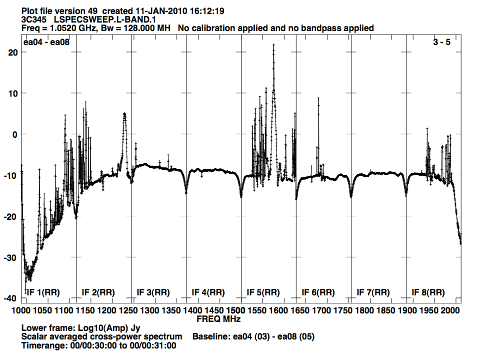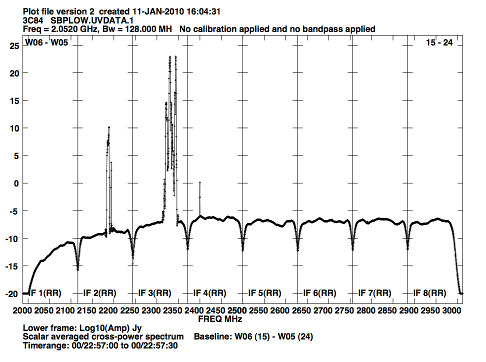Radio-Frequency Interference
The bands within the tuning range of the EVLA which are allocated exclusively to radio astronomy are 1400-1427 MHz, 1660-1670 MHz, 2690-2700 MHz, 4990-5000 MHz, 10.68-10.7 GHz, 15.35-15.4 GHz, 22.21-22.5 GHz, 23.6-24.0 GHz, 31.3-31.8 GHz, and 42.5-43.5 GHz. No external interference should occur within these bands. RFI is primarily a problem within the low frequency bands, and is most serious to the D configuration, as the fringe rates in other configurations are often sufficient to reduce interference to tolerable levels.
Radio frequency interference (RFI) at the EVLA will be an increasing problem to astronomical observations. Table 10 lists some of the sources of external RFI at the VLA site that might be observed within the EVLA tuning range. Figure 3 shows a raw power spectrum at L-band. Figure 4 shows a similar plot for the new S-band system. Table 10 gives a summary of the origins (where known) of the prominent features shown in the two figures.

|
Figure 3: Spectrum of L-band RFI. This shows the major interfering signals seen across the full 1 GHz bandwidth available to the L-band receivers. Each of the eight "spectral windows" displays 128 MHz from a separate sub-band. These are raw data, uncalibrated for the bandpass of either the digital filter or the receiver. The high linearity of the EVLA's electronics and correlator will permit astronomical observing within any frequencies not containing external interference. Note that the y-axis is in logarithmic units (dB). |
|---|---|

|
Figure 4: Spectrum of S-band RFI. This shows the raw spectrum of the lower half of S-Band - 2.0 to 3.0 GHz. No significant RFI is seen in the upper half. The major interference at 2.35 GHz is from satellite radio. The y-axis is in logarithmic units (dB). |
| Frequency (MHz) | Source | Comments |
|---|---|---|
| 1025-1150 | Aircraft navigation | Very strong |
| 1200.0 | VLA modem | |
| 1217-1237 | GPS L2 | Very strong |
| 1243-1251 | GLONASS L2 | |
| 1254 | Aeronautical radar | |
| 1263 | Aeronautical radar | |
| 1268 | COMPASS E6 | |
| 1310 | Aeronautical radar | |
| 1317 | Aeronautical radar | |
| 1330 | Aeronautical radar | |
| 1337 | Aeronautical radar | |
| 1376-1386 | GPS L3 | Intermittent |
| 1525-1564 | INMARSAT satellites | |
| 1564-1584 | GPS L1 | Very strong |
| 1598-1609 | GLONASS L1 | |
| 1618-1627 | IRIDIUM satellites | |
| 1642 | 2nd harmonic VLA radios | Sporadic |
| 1683-1687 | GOES weather satellite | |
| 1689-1693 | GOES weather satellite | |
| 1700-1702 | NOAA weather satellite | |
| 1705-1709 | NOAA weather satellite | |
| 1930-1990 | PCS cell phone base stations | |
| 2178-2195 | ??? | |
| 2320-2350 | Satellite radio |
Plots and tables of known RFI are available online, at http://science.nrao.edu/facilities/evla/observing/RFI/; plots of all RFI observations from 1993 onwards are available online, at http://www.vla.nrao.edu/cgi-bin/rfi.cgi. For general information about the RFI environment, contact the head of the IPG (Interference Protection Group) by sending e-mail to nrao-rfi@nrao.edu.
The impact of RFI on astronomical observing depends on the configuration and wave- length. It is worst for the D configuration, but RFI effects, as seen in an image, will be appreciably attenuated in the extended configurations and at higher frequencies due to fringe phase winding.
The EVLA electronics (including the WIDAR correlator) have been designed to minimize gain compression due to very strong RFI signals, so that in general it will be possible to observe in spectral regions containing RFI, provided the spectra are well sampled to minimize Gibbs ringing, and spectral smoothing (such as Hanning) is applied. We fully expect useful astronomical data to be extracted even if extremely strong interfering signals are located a few MHz away.
Extracting astonomy data from frequency channels in which the RFI is present is much more difficult. Testing of algorithms which can distinguish, and subtract RFI signals from interferometer data is ongoing.




Connect with NRAO